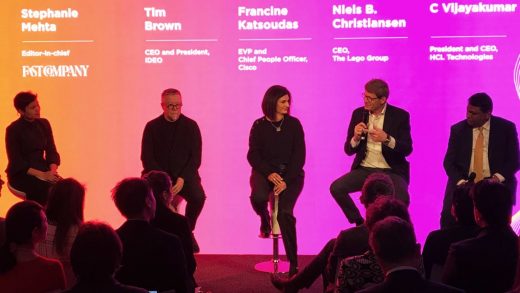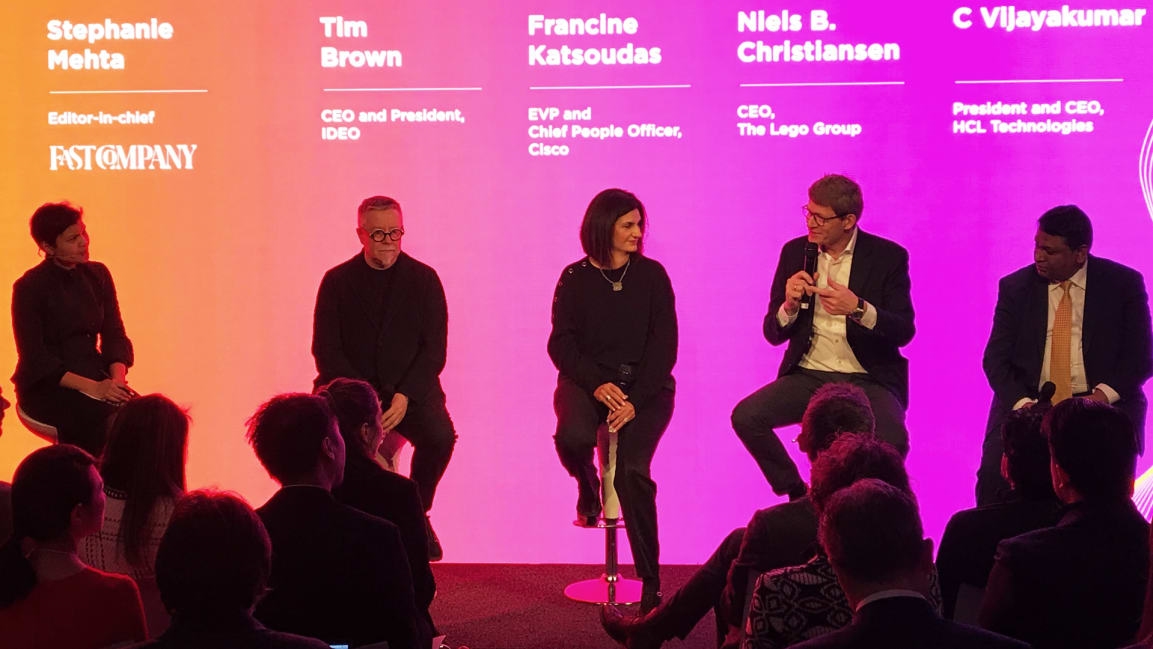From Cisco to Lego: The secrets to unlocking organizational creativity
It’s easy to say that creativity is an essential part of an organization, but fostering it is another thing entirely. Friday morning, four business leaders sat down in Davos, Switzerland, and discussed just that.
As the World Economic Forum started to wind down, Cisco chief people officer and EVP Francine Katsoudas; Lego Group CEO Niels B. Christiansen; HCL Technologies CEO and president C Vijayakumar; and Ideo CEO Tim Brown sat down with Fast Company‘s editor-in-chief, Stephanie Mehta, and talked about how to create an organization that truly taps human creativity. One simple answer the four all agreed on: the need for smooth and autonomous internal teams.
According to Katsoudas, Cisco has found a way to enhance its workforce’s creativity. “We know that all of our biggest breakthroughs happen on teams,” she explained. This isn’t anecdotal, either. A few years ago the company studied how different teams worked and then evaluated what they accomplish. The company identified 100 teams that were working well and added a control group of 200 others to try and analyze what the winning aspects were.
“On our best teams,” she said, “our employees were playing to their strengths.” And the groups that were playing most to their strengths felt safety and trust in each other, as well as shared values. Teams that clearly contained those three elements–having employees play to their strengths, fostering trust, and sharing values–had higher company retention, said Katsoudas. She added that Cisco is continuing to research this issue as it feed directly into the company’s culture and employee experience.
For Christiansen, fostering creativity is a little bit different, as Lego is certainly a much different beast than Cisco. His method is to ask his team to think about things from the perspective of a kid. “We take children as our role models,” he said, “the way children act without any barriers.”
Lego, Christiansen went on, doesn’t just make throwaway children’s toys but creates something that teaches basic and necessary human skills. They span from “creativity to lateral thinking to empathy,” he said. To create such a product line, Lego employees must adopt that playful mindset from the get go. “We are very purpose-driven around that,” Christiansen said. “We create toys for people like us.”
Brown echoed the efficacy of teams. What people need to succeed in group efforts, he said, is “creative confidence,” or the ability to not only devise a novel idea, but take it beyond an initial inkling. “As they begin to build that,” he said, “they can participate in a creative team.”
From there, people are able to produce great ideas. “If you’ve conceived of the idea together,” said Brown, “it’s a lot easier.”
It may seem like an obvious point, but all four emphasized the need for leadership to learn how to foster better collaborations. Brown also recommends quantifying team output over individual performance. “It’s the collective action we care about,” he explained. The company has devised a method for analyzing certain “creative qualities.” They include a team’s purpose, its ability to experiment, how empowered its members are, and how collaborative they are.
Put together, the panelists agreed that no matter the industry, there’s going to be an increased need for new and indefinable skills as time goes on. As Christiansen put it, “we don’t know 80% of the [future] job roles. I guarantee you they will have a bigger need for creativity.”
Davos Dialogues, a series of editorial panels, videos, and news coverage, is produced in partnership with HCL Technologies.
(30)



